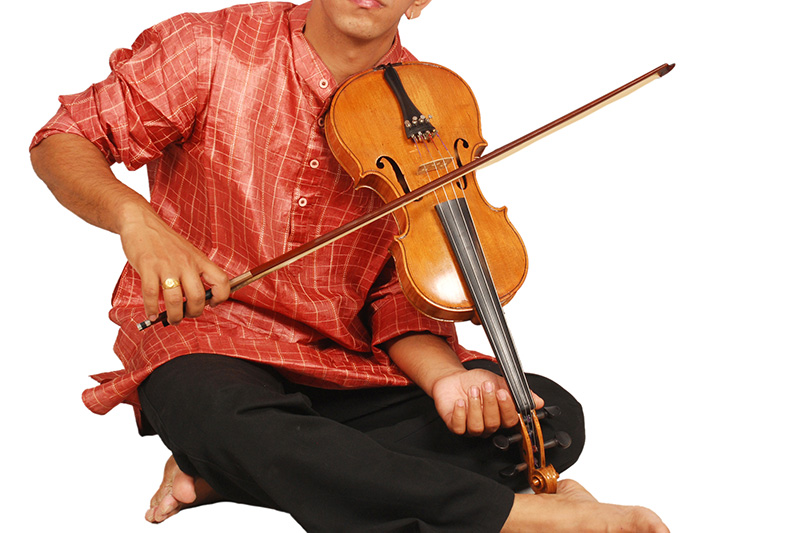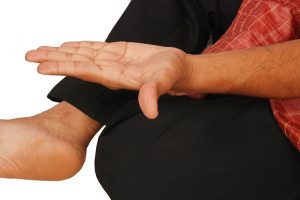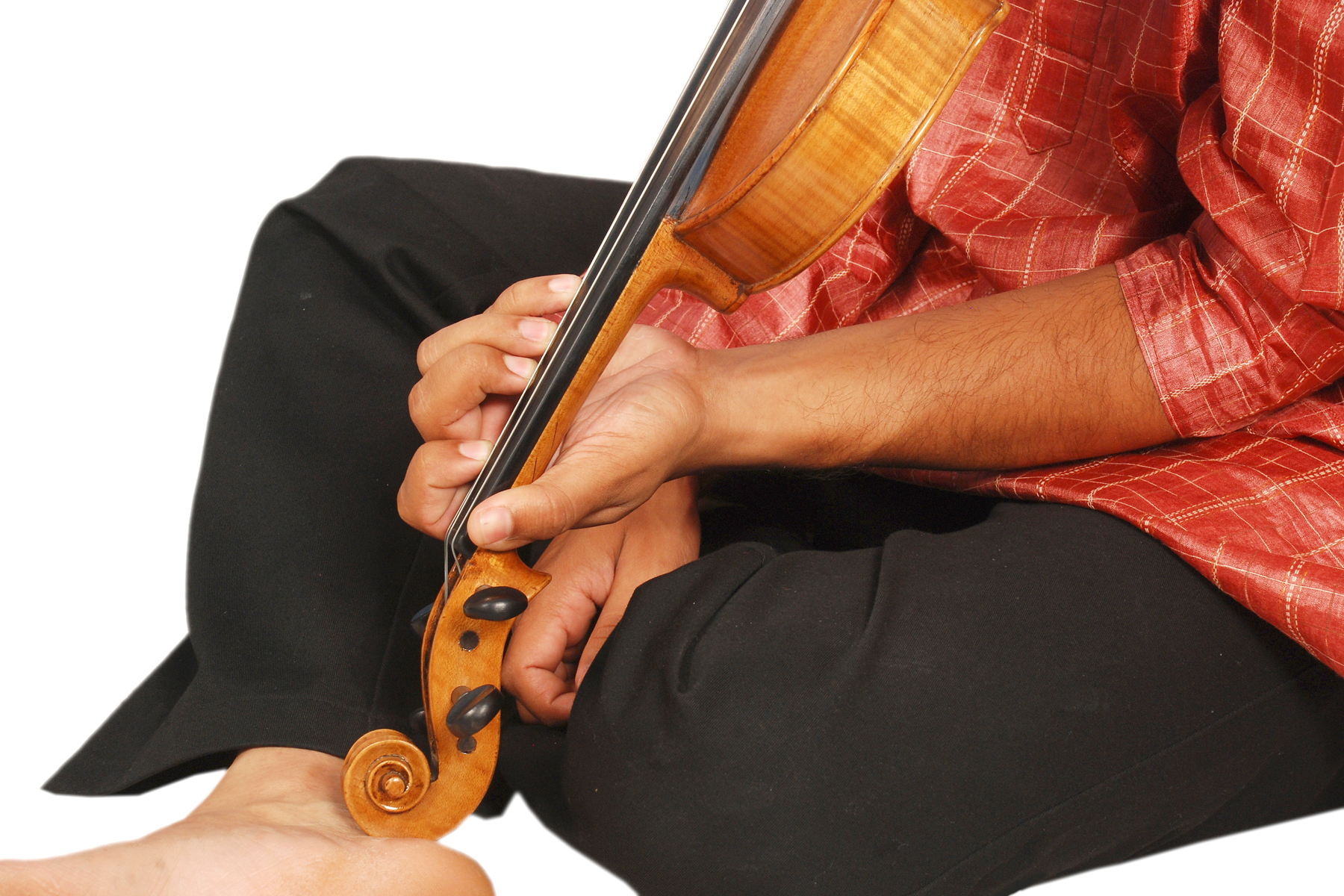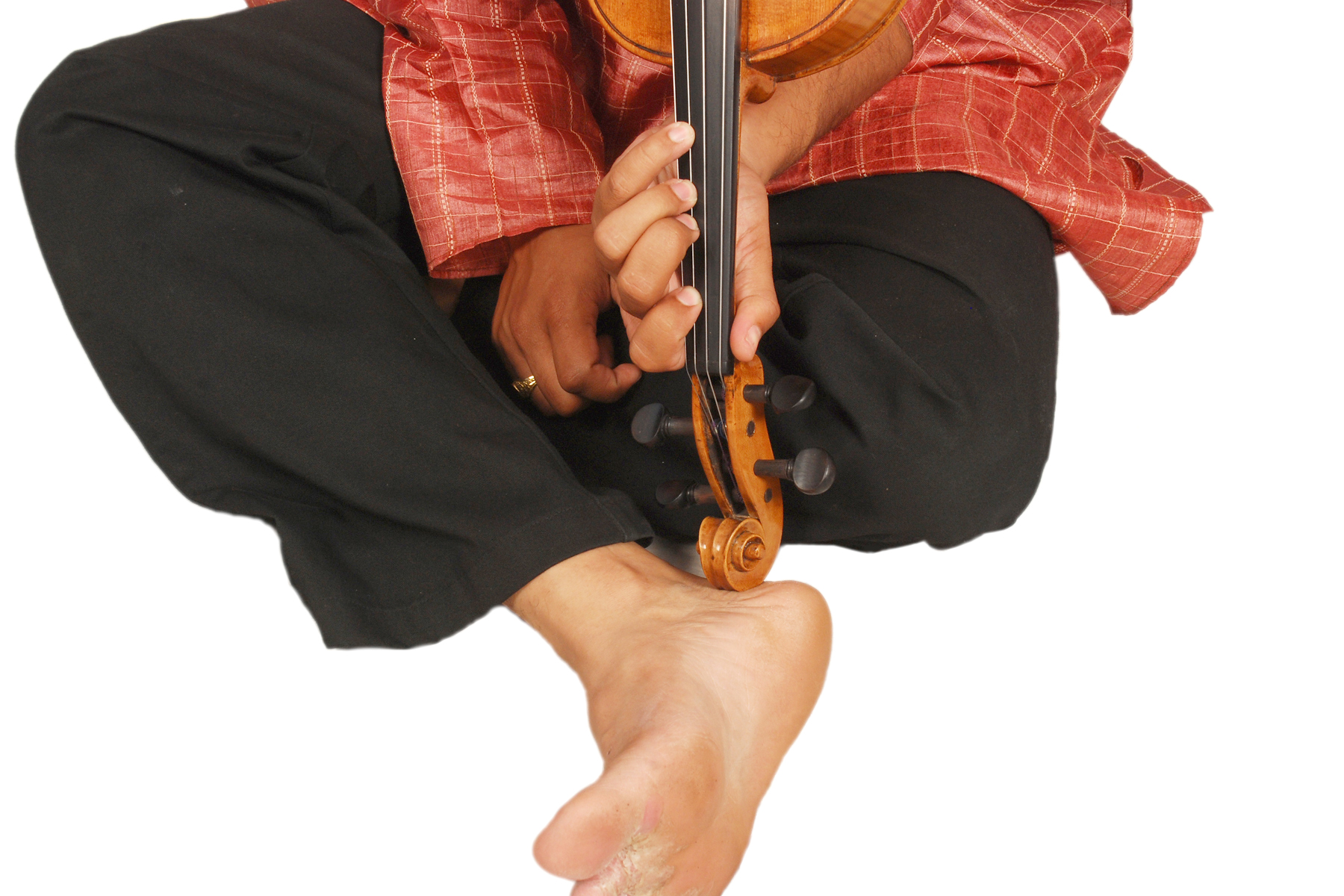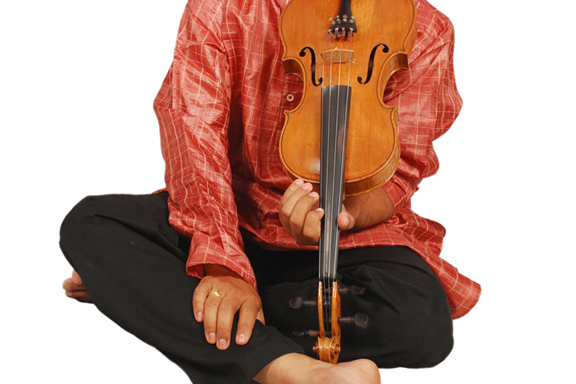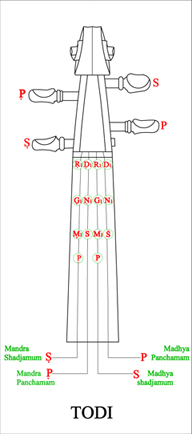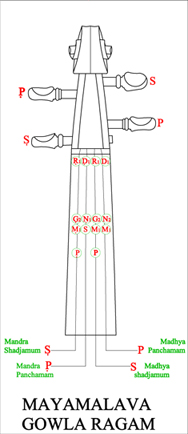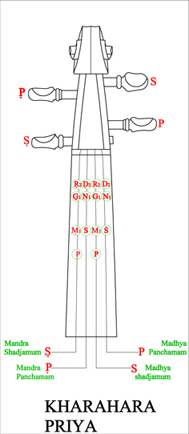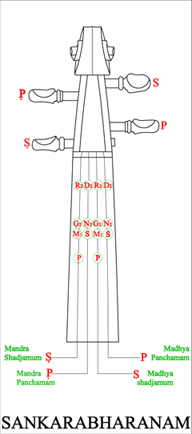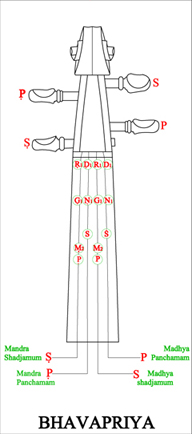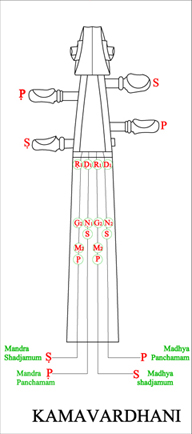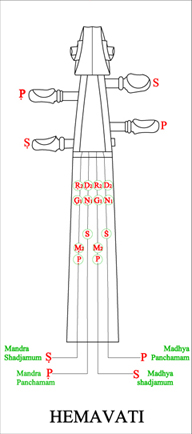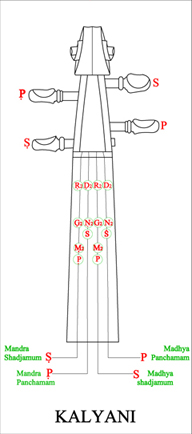INTRODUCTION
Violin has become an important musical instrument in Indian Music and Western music. Violin has been imbibed into carnatic music nearly 200 years ago. Initially it was used as an accompanying instrument and later it was extended to solo performance as well.
Carnatic music is primarily a vocal oriented music. It is adorned when vocals are accompanied with an instrument. It has been postulated that violin suites more than any other instrument for an accompaniment.
Hence, violin plays a prominent role in carnatic music. There has been a lot of progress made by many great artists in terms of style and methodology in which carnatic music is played on Violin. Since then, the artistry of playing carnatic music on violin has been blossoming. This Page is a humble attempt to prepare a vade mecum which introduces you to the history of Violin, the prodigious musicians/composers of carnatic music and the great violin artisans of the yester years. This Page also comprises of a methodology in holding and playing which is prepared from the opinions and suggestions of great vidwans and from an eclectic collection from various compendiums on violin.
ABBREVIATIONS
- O – Open String
- 1f – Index Finger
- 2f – Middle Finger
- 3f – Ring Finger
- 4f – Little Finger
- sa or s – Signifies Madhya sthayi : Similarly for the other svaras- s,r,g,m,p,d,&n; or sa, ri, ga, ma, pa, da & ni
- sA – Signifies Mandra sthayi : Similarly for the other svaras- sA, rI, gA, mA, pA, dA & nI
- Sa – Signifies Tara sthayi : Similarly for the other svaras- Sa, Ri, Ga, Ma, Pa, Da & Ni.
VIOLIN
Definition: Violin
“A four stringed instrument played with a bow. It is an unfettered fingerboard, consists of shallower body and capable of great flexibility in range, tone and dynamics”
History
There is a cogent evidence that bowed instrument were first manufactured and played in India. It has been confirmed by Engle (1874) that bowed instruments were played in India 2000 years ago Sonnerate, a French priest believed that 5000 years ago a bowed instrument called ‘Ravanastram’ was played by Ravana. Western Scholars researched regarding the same and penned the following lines in the ‘Violin’ category in “The Every Man Encyclopedia”.
Swati Tirunal, King of Travancore, encouraged Vadivelu, his Asthana vidwan to take up playing the violin Swati Tirunal presented an ivory violin to vadivelu in 1834. Later on Tanjavur Sivaramakrishna Iyear, Annaswamy Sastry, Fiddle Subrarayar of later generation of violinists helped a lot in future development of different styles of violin playing“It is generally agreed that stringed instruments played with a bow were used in Asia at a very early date, the oldest known form being the Ravanastrom, A hollow cylinder of wood with serpent skin stretched on one side, and strings fastened to a wooden rod. It was played with a bow of bamboo and horse-hair. To this curious instrument Indian tradition assigns the date 5000 B.C. when it was said to have been invented by Ravana, King of Ceylon.”
History reveals that during the erstwhile century’s people of Persia and Arabian countries have travelled to India for various reasons like trade et cetera. During those times the ‘Ravanilin’ , bowed instrument, was also commonly known amongst populace as ‘rabani’, ‘rabanamu’. The foreigners observed and perceived the wonderful aspects of this instrument and have taken it to their country in the seventh century or before that. Thereafter, they have adopted the instrument according to their tastes and preferences and with minor changes the ‘ravabani’ was greatly popularized as ‘rababa’.
With reference to the history of bowed instruments in the 9th century in Europe, in the kingdom of Byzantine Empire there was an instrument called ‘lira’.
A Persian geologist called IbnKhurradadhbin who belonged to the 9th century was the first one who has authoritatively advised the Byzantine Lira. Contemporaneously in the kingdom of Islamic Empires there was an equivalent instrument called ‘rabab’ was in practice. The Byzantine Lira had spread to the entire Western Europe. During the 11th and 12th century, when the European writers had to refer a bowed instrument they used the words ‘fiddle’ and ‘lira’. At the same time the instrument called ‘rabab’ has entered the Iberian Peninsula through Western Europe. These two bow instruments have spread to the whole of Europe and have helped for the further invention of bow instruments.
There were only two bowed instruments which have been used in the later centuries in Europe, which are as follows.
- A square shaped instrument fits in the hand, was given the Italian name which belonged to the family of Lira da Braccio (meaning veil for the arum).
- The other instrument slid from the shoulders to the legs and was given the Italy name Lira da Gemba (or viola da gamba, meaning viol for the leg). During Renaissance the Gambas instrument was very special and important. But later due to Lira da Braccio, which belonged to the family of the Modern Violin, produced louder sounds and thus the gambas lost its existence completely.
Firstly this violin was invented in the 16th century in the North Italy in a place called Brescia. According to ancient documents and citations (1585-95) in Brescia, artists who played stringed instruments and made stringed instruments were considered as scholars. During Renaissance people who played and made stringed instruments like Viola da gambaViolone, Lyra ,Lyrone, Violetta and Viola da braccio were called as “maestros”.
During 1530’s, the word ‘violin’ not only came into existence of the Brescian Documents but also spread to the entire North Italy. History tells that violin was manufactured from Viola da braccio, rabab and Lira da braccio. In 1556 Jambe de Fer discussed about violin and its tuning techniques in his book “Epitome Musical”. At that time itself violin had spread to the entire Europe.
It is said that Andrean Amati who belonged to a place called Cremona had manufactured a true violin and, in fact an argument was put forth that violin was manufactured 50 years before it was actually recorded in the documents. Andrean Amati was a great ‘lute’ instrument manufacturer. In those archaic days the musical instrument ‘lute’ was used by kings and royal families. But in the 16th century people of the Medici Family ordered for a musical instrument like lute which could be played by the common artists.
As mentioned earlier Andrean Amati was a great lute instrument manufacturer. But, in 1550-60’s he was surprised to see the business of Brescian violin and decided to change his own business. The documents of the year 1636 reveal that the Brescian violin business was very strong. Later the manufacturers who were famous in Brescia were affected by plague and died because of which Cremona’s business has gradually budded. A violin is a four strings instrument. Later Andrean Amati decided to make a violin with perfect and exact measures and in a same design using a hollow statue. As the body of the violin was very small it gained immense popularity. And this violin was within the reach for street artists as well as the royal families.
The development was in the same manner until 1644-1737 where Antonius Stravidarius the student of Nicholas Amati independently developed a violin which could be used for stage performances, blend with all ease was manufactured.
The oldest confirmed surviving violin, dated inside, is the “Charles IX” by Andrea Amati, made in Cremona in 1564. The Metropolitan Museum of Art has an Amati violin that may be even older, possibly dating to 1558.The famous artisans from 16 to 18th century who manufactured the violins are called ‘Luthiers’.
VIOLIN ARTISTS
Introduction
Violin has been introduced to Carnatic music during the end of 18th century and start of 19th century.
Violin became popular with the Carnatic parlance not only as the accompaniment ,but also as a solo instrument. Since 19th century, many great violin artistes have been developing the techniques involved. This is a humble effort to know a few of such great personalities.
At first, BalaswamyDikshitar who belonged to the lineage of Mudduswami Dikshitar started with violin, and practiced to inculcate it into Carnatic music. Thereafter, it was carried on and improvised by other eminent personalities like Varahappa Iyer, Sri Vadivelu, Sri Krishna SwamyBhagavatar etc. They were responsible for introducing the violin to general populace.
Balaswamy Dikshitar (1786-1858)
Sri Balaswamy Dikshitar was the son of Sri Ramaswamy Dikshitar, and brother of Nadajyothi Sri Mudduswamy Dikshitar. He has the knowledge of sense and essence of Carnatic music. He was influenced by Manali Mudalaichar, and learned violin from a European Violinist in Madras. After that, he has introduced the methodology of playing Carnatic music on violin. It is known that Sri Mudduswamy Dikshithar, who was not only his guru but also his brother, has composed “Nottu Swarams” in Sankarabharanam Raga for practicing them on violin.
He took up as the Aasthana Vidwan of the Pattaipuram from 1825. He was also the music guru for the Maharaja of Pattaipuram. He along with his brother Chinna swamy Diskshitar, gave many performances.
Varahappa Iyer
Sri Varahappa Iyer was the minister in the Marataasthana of Tanjavur. As his profession demanded he was proficient in English. He had eminent knowledge in Carnatic music. Once as he visited the British governor’s place, he came to see many western instruments. Because of the amicableness with the British Governor, he had a chance to play those instruments. Although he was initially attracted to Piano, later on he was strongly convinced that Violin can be befitted to Carnatic music. With a little practice he was able to play it comfortably; and because of that violin was presented to him by the British Governor. Thereafter, he gained expertise over the violin and used it as an accompaniment to vocal.
Valadi Radha krishna Iyer (1840-1908)
Valadi Radhakrishna Iyer was a great Violin Vidwan. He has accompanied great personalities like Mahavaidyanath Iyer, Pattanam Subrahmanyam Iyer etc. He has even given solo performances on many occasions. He was responsible for the introducing violin in Lagudi’s lineage. His descendants continued it for 3 generations.
Tirukkodikaval Krishna Iyer (1857-1913)
Tirukkodikaval Krishna Iyer has learnt violin during his childhood from his father Kuppuswamy Iyer. Further, he continued learning as disciple of Kothavasulavenkataramana Iyer. It was under the tutelage of famous Violin artiste satanurpanchanandiyer and Fidel subba Iyer he learnt many nuances of the art. Krishna Iyer played with a panache and class. He has accompanied eminent personalities like ‘mahavaidyanathIyer’ , ‘PattanamSubramanyam Iyer’ and ‘sarabhsastri’etc. He also had flair for solo performances. He had a unique element called “izhaittuvasittu” while playing. His style of traversing the strings is quite fast and leaves the listener mesmerized. He had many disciples, including prominent personalities like semmangudinarayana swami Iyer, Tirukkodikavalramaswamy.
Sri Dwaram Venkata Swamynaidugaru’s (1893–1964)
Sri Dwaram Venkata swamynaidugaru’s style of playing pure notes, and the methodology involved in playing Bow has made him a world-beater in the world of violinist in Carnatic parlance. While adhering to the Carnatic standards while playing, he has carefully adopted the techniques of western parlance making it very pleasing to listen to. He fantastically showed the sound difference of playing a long bow in a soft and hard manner. He has epitomized the sound sustenance of long bow on violin. He intrinsically has a sound understanding of laya. His style adheres not only to the gatra dharma but also to the vaidya dharma. History suggests that he is the foremost person to play the full/longbow style on the violin. He has performed more as a solo performer than an accompanist.
Milaikottai Govindaswamy Pillai (1897-1931)
GovindaswamyPillai has initiated learning of the Vocal and Violin from sriUmayalpurampanchapakesaiyer. Further, he pursued learning the art of violin from ‘sriyattipuramkodandapanibhagavathar’. He was quite famous as a violin artist during those times. The maturity in his style of playing made him play the sangatisin krithis mellifluously and with purity. He was known for his melodious ragalapanaand ability to play in three sthayis and three kalas proficiently. While adhering to Carnatic music ordinances, he had developed his own unique style. He had created a new phenomenon during those times. His accompaniment to Carnatic vocalists was a dulcet. He had a very good grip over ragalapana and kalpanaswaram. His methodology of playing tanamserved as a boon to other next generation violinists.
Mysore T Chowdaiha (1895-1967)
Sri Chowdaiha was a very famous violin artist. His presence double folded the mellowness in the concert. He gave many performances as an independent solo performer. He created a sensation by playing a seven stringed violin. His greatness lies in accompanying forte vocalist like chembaivaidyanathbhagavathar with equal sound quality and loudness, during those times when there were no electrical mikes. Because of this unique feature of his tonal loudness, his accompaniment was indispensable to carnatic vocalists. In order to produce such loud tones, he used a 7 stringed violin. His Violin has the first, second and third strings (from right to left) and another set of same strings to its left. While playing, he used to touch two strings at same time, thereby increasing the tonal intensity. This can be told as an experimental phenomenon.
Kumbakonam Raja ManikyamPillai (1898 – 1970)
Sri Pillai’s style was elegant, classy, melodious and befitting Carnatic ordinances. His style of playing gamakasare laudable. He was praised by the contemporary Carnatic artisans. He was an epitome of humbleness. His humility, amicable nature made him quite friendly with his peer group.
Papa Venkata Ramayya (1901-1972)
Sri Venkata Ramayyagaru is a stager in the field of Violin accompaniment. He is also noted for his solo performances. He is known for his easiness in adopting to style the main artist during accompaniment. He is well known for the elusiveness in the use of lower octave strings. Ramayyagaru inculcated the intricacies of techniques of accompanying a Tanam from his guru sri gurugovindswamipillaigaru. His playing style is usually associated with melody and bliss to listen to.
CARNATIC MUSIC & BASICS
Introduction
The ocean of Indian classical music is an ecstatic combination of two systems Carnatic and Hindustani music. While Hindustani music is confined to North Indian parts of the country, the Carnatic music gained wide popularly in the south India States of Andhra Pradesh, Tamilnadu, Karnataka and Kerala which together are referred to as Karnataka and hence the name Carnatic music. The name Carnatic has been divided from two words ‘Karna’ meaning ‘ear’ and ‘atakames’ meaning ‘pleasing’ so carnatic music is that which is ‘pleasing to the ear’.
The present Carnatic music has been developed systematically in the form of graded lessons by the pioneer of classical music, SriPurandaradasa’ who lived between 15th and 16th centuries hence he is also called ‘Sangita Pitamaha’
Ganasystems
Carnatic music may be divided into two categories a) Abhyasa gana b) Sabha gana.
Abhyasa Gana:
‘Abhyasa’ means ‘learning through practice’. The roots of Carnatic music are found in the very beginning lessons of sarali, Janta, Dhatu, Geetams, swarajaties, jati swaram & varnam which represent the foundation phase. Abhyasa gana represents this phase, which helps in internalising the nuances of Carnatic music.
Sabha Gana:
The singing of various forms of music namely kritis, keertanas, padams, Javalies, Thillana which are the various forms of kalpita(created) sangita composed by various composers and the forms of manodharma(spontaneous creation) sangita like alapana, swarakalpana, niraval, tanam, pallavi form the advanced phase of the Carnatic music and form the part of Sabha gana.
Swaras and Formation of melakarta ragas:
Swara:
Literally that which pleases of its own accord is swara or musical note
–Prof.P. Sambamoorty
Raga:
Literally that which creates passion or rasa. It is a melody mould or melody type. Raga is the pivotal concept of Indian music. Every raga is an aesthetic entity and has a tonal personality and is capable of being recognised by a trained ear.
Prof.P. Sambamoorty
Swaras are the basic units and the smallest tonal regions, which form the units of a melody. The number of swara units that take part in a melody is mentioned with reference to one sthayi. Taking a chromatic pitch pipe or a piano, if we proceed from a note in ascending /descending order until we reach the similar note we observe 12 different swaras. Thus, a sthayi has 12 parts or sthayi is divided into 12 parts. All these 12 swaras are assigned the names of the basic 7swaras (saptaka), which are found in the classical music of our country. The table below shows the 7 basic notes found in Carnatic, Western, and Chines music systems.
| 1 | Shadja | Sa | doh | Koung |
| 2 | Rishabha | Ri | ray | Chang |
| 3 | Gandhara | Ga | mi | Kio |
| 4 | Madhyama | Ma | fa | Pion-Tche |
| 5 | Panchama | Pa | sol | Tche |
| 6 | Dhaivata | Da | la | Tu |
| 7 | Nishada | Ni | si or te | Pion Koung |
Saptha swaras are represented by solfa syllables ‘S R G M P D N’ Among the sapta swaras except for sadjam and panchmam, the remaining 5 swaras R, G, M, D, N exhibit 2 variations each in their pitch positions as observed from various ragas in Carnatic music. The variations in r g m d n are as shown.
| 12 Svaras | 16 Svara Names | Solfa – Svaras |
| 1 | Shadja | Sa |
| 2 | Sudha Rishabha | R1 |
| 3 | Chetusruti Rishabha Sudhagandara | R2 or G1 |
| 4 | Sadharana Gandhara Shatsruti Rishabha | G2 or R3 |
| 5 | Antara Gandhara | G3 |
| 6 | Sudha Madhyama | M1 |
| 7 | Prati Madhyama | M2 |
| 8 | Panchama | Pa |
| 9 | Sudha Dhaivata | D1 |
| 10 | Chatusruti Dhaivata Sudha Nishada | D2 or N1 |
| 11 | Kaisika Nishada Shatsruti Nishada | N2 or D3 |
| 12 | Kakali Nishada | N3 |
In the above-mentioned 12 swarasthanas, if we take one variety of each R, G, M, D, N and combine with S and P we obtain a melakartha raga.
In a melakartha raga, all the 7 swaras should be present both in Arohana(ascending order of swaras) and avarohana (descending order of swaras) respectively. Similar notes should Figure both in aro & ava.
Ex: S, R1, G1, M1, P, D1, N1, S (Thodi ragam)
In the given example if we replace R1 with R2 we obtain a different melakartha ragam i.e. S, R2, G1, M1, P, D1, N1, S (Natabhairavi ragam) using the same method – – Prastaram we obtain 32 melakartha ragas with different combinations. Among 32 melakartha ragas there are 16 sudhamdhyama ragas and 16 pratimadhyama ragas.
A special feature in carnatic music is that these 12 swarasthanas are being categorised into 16 prakruthi and vikruthi swaras. They are below:
- Chatusruti Rishabah Ri(R2) – Sudha Ga(G1)
- Sadhrana gandhara Ga(G2) – Shatsruti Ri(R3)
- Chatusruti Dhaivata Da(D2) – Sudha Ni (N1)
- Kaisikaini Nishada Ni(N2) – Shatsruti dha (D3)
In this manner we obtain
- 3 Varieties of R
- 3 Varieties of G
- 3 Varieties of D
- 3 Varieties of N
these together with 2 varieties of M and the Prakruthi swaras S and P make up for the 16 swarasthanas refered to as shodasa swarasthanas. By the prastara of these 16 swarasthanas we obtain 72 melakartha ragas.
If we combine one varity each of R G M D N and S & P we obtain a melakartha raga. In 72 melakartha ragas 32 ragas above mentioned and 40 vivadi ragas.
Ex: S R3 G3 M3 P D3 N3 S (Chalanata raga)
Note: Vivadi ragas.
How to Play Violin
Introduction
There is a difference in tuning the violin in carnatic music as compared to the western music. In a similar way, there is a difference in holding the violin as well. Unlike the Western music, Indian classical music doesn’t restrict transposing the left and the right hand usage. There is a difference in the style of holding the bow and other aspects, across various pedagogic institutions; nevertheless it would be an onerous task to narrow down and single pick the best methodology. There has an harmonization done in terms of handling the violin and the involvement of the right and the left hand based on western style of playing violin, and based on the suggestions of great stalwarts of carnatic violin.
Tuning of the carnatic violin:
In carnatic music tune is done on the basis of ‘Sa’(Shadja) and Pa (Panchamam). A vocalist according to his voice or an instrumentalist according to his instrument chooses the ‘Adhara Shadjamam’.
All the swaras related to one octave are in accordance with swara Sa(Shadja). Panchama swara(Pa) is samvadi swara of ‘Sa’. There are four strings in the violin. From left we call the first string as ‘G’ and is tuned as’Mandra Sthai ‘Sa’, Second string ‘D’ as mandra sthai ‘Pa’, third string ‘A’ as madhyamasthay ‘Sa’ fourth string ‘E’ as madhyamasthay ‘Pa’. All the above four strings are tuned accordingly.
Learners of violin, with the help of pitch pipe of Electronic sruti box, Electronic keyboard, Piano choosing the pitch or Adharashadjamam, have to tune ‘Sa’ ‘Pa’ ‘Sa’ ‘Pa’ or ‘D’ ‘A’ ‘D’ ‘A’. Generally in carnatic music, who gives violin solo concerts, use Adharashadjamam as D, E, or F
Holding the violin:
As shown in the Figure 1, one has to sit down and stretch the right leg to the front and put the left leg under the right thigh. The scroll of the violin should be kept on the Front inner heel or the ankle, the neck of the violin should be supported by the left side chest or the collar bone. The violin should be held between the leg and the chest without any support of left hand. In case of taller persons, it would be easier to support it a little below the chest. As shown in the figure1, in case of a children or shorter persons, it would be better to support the bottom side of the violin at the chest and the neck of the violin at the throat below the chin. With an exception of these small deviations, the way in which the violin is held is similar amongst all the artists. The left hand position should be such that the neck of the violin should fit in the ‘U’ shape formed between the Left thumb and the rest of the fingers.
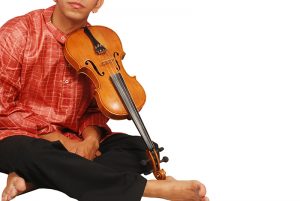
Fig.1
RIGHT HAND TECHNIQUES
We can see the difference in holding the bow from person to person. So we exactly cannot say which way is correct. Taking pieces of advice from violin celebrities, one way of holding the bow is determined according to different contexts of playing violin in Carnatic music Some artisans have expressed their opinion on the right hand finer positions while holding the bow as follows.
“The thumb of the right – hand goes inside and is curved. It is placed near the frog. Whereas the other right hand fingers, namely, the index finger, the second finger, the ring finger and the little finger, placed above the stick portion of the bow”
“While fourth or the little finger helps in maintaining the equilibrium of the bow, the index finger helps in giving to the stick”4(Dr.M.Lalitha 2004:55)
“The index finger should slightly press the bow, and little finger relieve the pressure, the middle two fingers helping in the process of bowing as a whole”5(C.S.Ayyar 2002:29).
Before learning how to hold the bow, let us learn its different parts. The parts of bow are identified in Fig 2.
As shown in Fig 2 the bow is mainly divided in to 3 parts.
1. Frog or heal of the bow- the lower part of the bow.
2. Middle of the bow- middle part
3. Tip of the bow – the upper part of the bow.

Fig.2
By bending the thumb and placing its tip in the small curve of the frog or near the frog as shown in the fig.3 and fig.4 and keeping the rest of four fingers across the bow with the tip of the little finger touching the screw.
Before start playing it is important to know the movements of the right arm and wrist on the heel, middle, and tip of the bow positions. As shown in the fig 4,5, & 6 while playing with the bow at the ‘Heel portion the hand is bent forward of the wrist and at the ‘middle portion’, the hand is straightened and at the tip portion the hand is bent back ward.
When the lower portion of the bow moves down ward it is called ‘Down-Bow’ and when it moves upward it is called ‘Up-Bow’.
LEFT HAND TECHNIQUES
While right hand is used to producing sound on the violin, left hand is used for producing notes (swaras) on the violin. Let us now see the usage of left hand techniques. See them a gap of 1 to 2 inches between the left fore arm and left thigh. Slightly move your left forearm downwards to the right. Keep your thumb away from the four fingers.
Fig.8
Playing the Saptha (seven) swaras
1. Carnatic music begins with a raga called “Mayamalavagoula” & its swaras are sa, ri, ga, ma, pa, da, ni (Shadja, Sudha Rishabha, Antara Gandhara, Sudha Madhyama, Panchama, Sudha Dhaivata, Kakali Nishada)
2 Middle Octave Swaras ‘ri’ ‘ga’ ‘ma’ are played with the index, middle and ring fingers on the ‘sa’ string(string –A) and ‘da’ ‘ni’ ‘Sa’ on the ‘pa’ string(string – E) as shown below. All these seven swaras which are played on the string A & E are called middle octave swaras.
LOW & HIGH PITCH NOTE
In carnatic music, violinists, when play high pitch notes they use fingers according to the convenience
Low Pitch notes:
As mentioned before violin has four strings – G,D,A, & E. Sting G is tuned Mandra Shadjamam sA, String D is tuned Mandra Panchamam pA. Mandra Sthai rI, gA, mA are played on Mandra Sthai Shadjamam sA (String G) and dA, nI on Mandra Sthai Panchamam pA (String D).
Note: The Swaras with a dot beneath them are called Lower octave the Swaras with out dot are Middle octave .The swaras which have dot above them are called higher octave.
High Pitch Notes:
In violin, 4th string from left is ‘E’ which is tuned as Madhya sthayi ‘Pa’. Higher notes Sa, Ri, Ga, Ma, Pa, Da, Ni are played on Madhya sthai ‘Pa’. In the fig no. Raga Maya malava gowla higher pitch notes are shown on ’P’ string.
Thumb has two positions to keep on when we play ‘Madhya sthayi swaras, the thumb is in First position means opposite to suddha divatham(Index finger f1) When playing higher notes the thumb is in second position i.e. opposite to higher shadjamam ‘s’ or a little bit lower see the Fig.11
Conclusion
The Art of playing carnatic music on violin has been developing since 200 years. This article describes a procedural approach of holding the violin, right and left hand usage etc.The intent of the article is to provide information about the history of violin and the Violin artisans of carnatic music; and introduction on carnatic music and how to handle carnatic music on violin.
Reference
1. Alberto Bachmann, “An Encyclopedia of the Violin” Da Capo Press, 1965.
2. Ayyar, C.S. “The Art and Technique of Violin play and other essays on music”, Madras, Indian Publishing House, Fifthe Edition. 2002.
3. Bhagya lekshmy.S “Carnatic Music Compositions” Sivakasi CBH Publications. 2001.
4. Lalitha. M “Violin Techniques in Western and South Indian Classical Music” New Delhi, Sundeep Prakasan, 2004.
5. Prem Kumari. V “Experiments in Music Teaching” New Delhi, Radha Publication, 1995.
6. Ravi Kiran. G “Appreciating Carnatic Music” Madras, Ganesh & Co., Second Revised Edition 2006.
7. Sambamurthy. P Prof “History of Indian Music” Chennai, The Indian Music Publishing House, Fifth Edition, 2005.
8. Sambamurthy. P
i. “A Dictionary of South Indian Music and Musicians” Volume – I (A-F) Madras, The Indian Music Publishing House, Second Edition, 1984.
ii. “A Dictionary of South Indian Music and Musicians” Volume -II (G-K) Madras, The Indian Music Publishing House, Second Edition, 1984.
iii.“A Dictionary of South Indian Music and Musicians” Volume-III (L-N) Madras, The Indian Music Publishing House, First Edition, 1971.
iv.“A Dictionary of South Indian Music and Musicians” Volume-IV (O-S) Madras, The Indian Music Publishing House, First Edition, 2007.
V. “Great Musicians” Madras, The Indian Music Publishing House, III Edition, August 1996.
9. Satyanarayana. R “Origin of the Violin in Carnatic Music” Vidwan Anoor Rama Krishna 60th Birthday Felicitation. Volume (1991), 60.
10. William Sandys and Simon Andrew “History of the Violin” Dover Publication, 2006.
Telugu Books
11. Girmaji Rao “Violin” Potti Sree Ramulu Telugu University, Hyderabad
12. Pardhasaradhi and Dwaram Pardasaradhi “Ganakala Bodhini” Balasaraswathi Book Depo, Hyderabad, 1965
13. Akella Mallikarjuna Sharma “Sangeeta Swara Raga Sudha”, Hyderabad, First Publication, 2001.
14. Sri Pada Pinakapani “Manodharma Sangeetham” Sree Ramulu Telugu University, Hyderabad, 2004.
15. Eka Subbarao “Kotha Sangeeta Vidyadarpanam” Sri Mahalakshmi Book Enterprise, Vijayawada.
English Magazine
1.T.S.Mani, “Sruti India’s Premier Magazine for the Performing Arts” Title “Madras.06-Nov-2013.
2.Dr.Lalitha Muthuswamy, “Sruti India’s Premier Magazine for the Performing Arts” Title: “Global Violin traditions and styles”, Madras, 06-Nov-2013.
Telugu Magazine
1.Dwaram Durga Prasad “Kinara Dwibhasha traimasa Sangeetha Patrika”, Andhra Mahilasabha College of fin arts, Hyderabad, 2009.
2. Malladi Suribabu “Ganakala Sangeetha Masapatrika” Kakinada, March, 2012.
Web Sites
1. Krishnana G.J.R “www.carnatic.net/sangeet/gjrviolin.htm”
2. Mullaivasal Chandra mouli “www.chennailivenews.com/music/classical/20121319081332/history-of-carnaticviolin.aspx”
3. Narmada M.S. “www. parurnarmadhamusic.com/parurstyle.htm
4. Wikipedia “en.m.wikipedia.org/wiki/violin”





